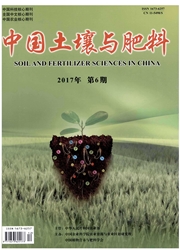

 中文摘要:
中文摘要:
采用筒栽试验,设置4个磷(P2O5)施用水平(0、60、120、180 kg/hm2),探讨盐碱地不同磷肥施用量对向日葵生长及光合特性的影响,为河套灌区盐渍化耕地磷肥合理施用提供借鉴.结果表明:盐碱地施用磷肥促进向日葵的根系生长发育和叶片生长,在向日葵现蕾期至盛花期效果最明显;施磷提高了现蕾期向日葵叶片的最大净光合速率,但对向日葵叶片叶绿素含量(SPAD值)没有显著影响;施磷也提高了灌浆期向日葵叶片全天净光合速率,在10:00和16:00时不同施磷量与CK之间差异均达显著水平;同时施磷还改善了向日葵收获时的农艺指标,显著增加向日葵各器官的干物质积累.在施磷量达到180 kg/hm2时,对向日葵的生长和光合特性的影响最显著.
 英文摘要:
英文摘要:
By setting tube experiment under field conditions,we aimed to exploit the influence on growth and photosynthetic characteristic of sunflower stemming from different amounts of phosphorus fertilizer (P2O5 0,60,120,180 kg/hm2),thus providing theoretical implications for the reasonable usage of phosphate fertilizer in saline cultivated land of Hetao irrigation district.The results showed that increasing the phosphate fertilizer application in saline soil promoted sunflower root and leaf growth and it showed the most obvious effect in the squaring stage and flowering stage of sunflower.The application of phosphate fertilizer also improved the net photosynthetic rate of sunflower leaves in the squaring period,but no significant effect on the chlorophyll content (SPAD value) of sunflower leaves was found.The application of phosphate fertilizer also increased the whole-day net photosynthetic rate of sunflower leaves in the filling period,and there were significant differences between phosphate fertilizer treatments and the control (CK) in 10:00 and 16:00.In addition,the application of phosphate fertilizer enhanced the harvest agronomic indicators of sunflower,and significantly increased the dry matter accumulation in various organs of sunflower.When the phosphorus reached 180 kg/hm2,it showed the best effect on the growth and photosynthesis of sunflower.
 同期刊论文项目
同期刊论文项目
 同项目期刊论文
同项目期刊论文
 期刊信息
期刊信息
